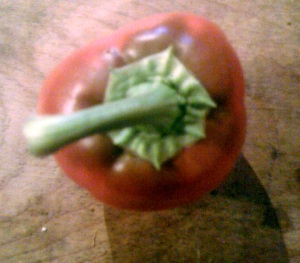We have a great garden growing on our rooftop in Brooklyn overlooking the construction of the new stadium at Atlantic Center. While watching them build the stadium, we’re growing some good ol’ Brooklyn produce.
At first, we planted in clay pots and plastic pots. We have cucumbers, tomatoes, peas, green-beans, green peppers, serano chiles, and lots of herbs.
The best growth we’ve had is with our kale. It grows wonderfully on the roof. Here’s a shot of the kale growing and a shot of cooked kale with garlic and hot red peppers:
I also tried a new method of growing tomatoes using a Sub Irrigated Planter (SIP). The idea is to water the plants from the bottom instead of the top. It’s far more efficient and you use a lot less water.
There are a lot of websites that help teach how to make your own SIP system. I like Global Buckets a lot. There’s also a company called Earthbox that sells kits. It’s not that hard to make one yourself – I recommend it so that you can really see how it works.
 We made our SIPs out of plastic buckets. In the photo at left, you can see Anya (wearing safety goggles of course!) drilling a large hole into one bucket. A smaller hold is also drilled next to the large one.
We made our SIPs out of plastic buckets. In the photo at left, you can see Anya (wearing safety goggles of course!) drilling a large hole into one bucket. A smaller hold is also drilled next to the large one.
 In the photo at right, you can see that a chinese food container with little holes drilled in it, is inserted into the large hole in the center of he bucket. A plastic PVC pipe is inserted into the smaller hole. It’s important that when you cut the plastic PVC pipe, one side is cut at an angle. The side with the angle is inserted into the bottom of the bucket. The angle is important so that water can flow through the tube into the bottom bucket.
In the photo at right, you can see that a chinese food container with little holes drilled in it, is inserted into the large hole in the center of he bucket. A plastic PVC pipe is inserted into the smaller hole. It’s important that when you cut the plastic PVC pipe, one side is cut at an angle. The side with the angle is inserted into the bottom of the bucket. The angle is important so that water can flow through the tube into the bottom bucket.
 The bucket is then inserted into another bucket. We drilled two holes into the lid — one for the PVC pipe and one for the plant to stick out of.
The bucket is then inserted into another bucket. We drilled two holes into the lid — one for the PVC pipe and one for the plant to stick out of.
The top bucket is filled with soil and whatever you are planting. You water by pouring water through the PVC tube. It fills up the bottom bucket and wicks into the soil through the chinese food container and then up to the roots of the plant. At left is a finished SIP.
 We have two SIPs working with cherry tomato plants that are doing wonderfully. It’s really not hard to build them and it’s a fun construction project. Anyone interested in container gardening for your rooftop, deck or even backyard should try to build these. Our finished SIPs are at right.
We have two SIPs working with cherry tomato plants that are doing wonderfully. It’s really not hard to build them and it’s a fun construction project. Anyone interested in container gardening for your rooftop, deck or even backyard should try to build these. Our finished SIPs are at right.
Below, I’m including a youtube video that explains how the construction process of a SIP more clearly than I did above. Enjoy!



















